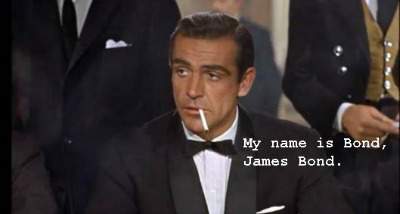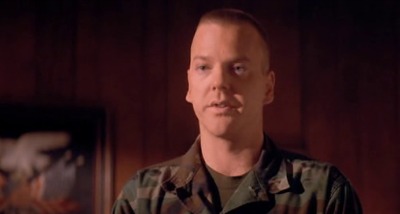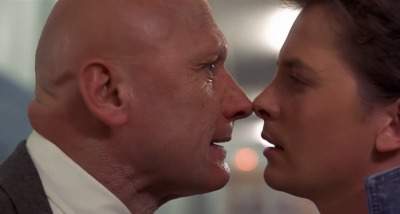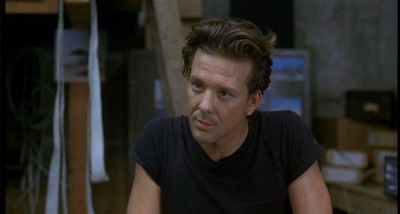Uninteresting and flat characters are one of the Top 7 Deadly Flaws of a Bad Screenplay and one of the main reasons for a screenplay to get tossed instead of read.
Find out how to create a compelling character and ensure the reader connects with him in this series of articles full of movie scripts and videos.

We asked our character expert, Alex, aka Cool Dude, to tell us how to create a multidimentional character that the audience would care about.
He came back with 11 steps to do so and 3 stages:
1. Creating your fictional character
2. Revealing him
3. Connecting with him
Step 4 is part of the second stage of the process, i.e. "Revealing your character".
In this article Cool Dude will cover the following points:
Forget your screenwriter hat for a second and imagine that you are a Reader.
And you just start reading a script.
In the first 10 pages you get a lot of information.
And you get to meet all the main fictional characters.
It's like going to a party and you know no one. And you get introduced to everyone in 10 minutes.

Unless the party goers are very different from each other and they make such a strong impression on you, there's a big chance that you won't remember their name, who they are and what they are up to.
The same thing applies to a script.
As a reader, you'll be spending the next 90 - 110 minutes with all these characters, so you want to be properly introduced.
That's where you count on the screenwriter to help you remember all the fictional characters, distinguish one person from another and get a sense of who they are.
There are 3 factors, that contribute to a great and memorable introduction, i.e. an introduction that hooks the reader, and the actor - if your screenplay makes it that far:
1. The name of your fictional character. See our 10 tips to choose the "right" name.  2. The description of your character and
2. The description of your character and
3. The scene when your character gets introducted.
When these 3 elements are well executed, they bring a fictional character to life, a fictional character that litterally jumps off the page.
As a screenwriter, you need to remember that a reader does NOT SEE the characters you created. Therefore, unless you provide him with a clear picture, he will use his imagination to fill in the gaps and may create a picture that is not in line with what you had in mind.
Screenwriting is not an exact science. As a result there are different views on what you can include in a character description.
Some screenwriting experts say that you can only mention the name and the age of your fictional characters in a description.
The thinking behind is that the other information will be revealed through dialogue and actions.
This is accurate over time. But at the moment of the introduction, the picture that gets evoked is pretty sketchy and subject to a lot of figuring out.
Some other screenwriting experts say you can mention the name and the age of the character as well as any relevant information provided one can see it.
Think of physical details, that could reveal something about the fictional character (e.g. a scar, some clothings).
According to that approach, anything that can NOT be seen, can NOT be included in your description and you will have to find another way to reveal it.
In terms of creating a picture in the mind of the reader, this approach is alreay a big plus compared to the first one.
Some great produced screenwriters take some artistic licence with above approaches and include in their description elements of the characters that we do NOT see but that create a very evocative picture.
This approach - that is only applicable to the description of characters - gets more common and demands practice to ensure it is skillfully executed.
Let's see how these 3 approaches play out with an example of American Beauty, screenplay written by Alan Ball:

"RICKY FITTS is eighteen."
"RICKY FITTS is eighteen, but his eyes are much older."
"RICKY FITTS is eighteen, but his eyes are much older. Beneath his Zen-like tranquility lurks something wounded... and dangerous."
Which approach creates and actually matches above picture of Ricky?
And which one has the most chance to hook the reader?
Yes, indeed, the third one.
You will discover below how to write such a description.
We analyzed more than 50 different screenplays and found out that each compelling character description had 12 characteristics.
Here they are:
It is usually 1-2 lines. Maximum 4-5.
This is an example from The Bourne Identity, screenplay written by Tony Gilroy and W. Blake Herron:
" ZORN is the number two here. Brilliant bloodless lapdog."

You read the description of the fictional character and a picture immediately pops up in your mind.
This is an example from A Few Good Men, screenplay written by Aaron Sorkin
"Lt. JONATHAN JAMES KENDRICK is 26, from Georgia, and an Academy graduate. If you asked him he'd tell you that the gates to heaven are guarded by the U.S. Marine Corps."

The description of the fictional character gets to the essence of the character. With a few words, we get to know who the character is. Fundamentally.
This is an example from The Great Gastby, screenplay written by Baz Luhrmann & Craig Pearce:
"NICK CARRAWAY (37), unshaven, morbidly alcoholic. "

This clue gives a context inside of which we will listen to the dialogue and watch the actions of the fictional character.
It can even tell us if the character is a good guy or not.
This is an example from The Perks of Being a Wallflower, screenplay written by Stephen Chbosky:
"SAM (17) would make every mother proud and every father nervous. She is alive, adventurous, and a world class flirt. Great attitude. Great taste. Great banter."

If you introduce a physical detail in the character description, the reader will expect it to be relevant in the story. So make sure it is and do not set the reader on the wrong foot by adding details which do not matter.
This is an example of what works. It is from American History X, screenplay written by David McKenna:
"TIGHT ON DEREK VINYARD. The young man has a shaved head, a thick goatee, and a well-crafted SWASTIKA on his left tit."

All these details contribute to the creation of a picture of a die-hard neo-nazi.
And out of this physical description, we know Derek is trouble.
The description should provide the actor with clues on how to play the character.
In that light, saying that someone is beautiful does not give any access to an actor. How do you play "beautiful"?
This is an example of a description that is actable.
It comes from This Boy's Life, screenplay written by Robert Getchell:
"The boy is TOBY WOLFF. A pleasant-faced boy with wonderful eyes, he is 13 -- teetering on the brink of adolescence, so that one moment he seems like a self- assured teenager, and the very next like a ten-year-old kid. Just now the ten-year-old kid has the upper hand: bored and weary with the long trip. "

The description of your fictional character should be general enough to fit a great number of actors. If you say that your hero is 6 feet 8, that will limit considerably the number of actors who can play that role.
By the same token, do not refer to actors in your description. For example: "John, a Brad Pitt type", or "Peter looks like a clone of Matt Damon".
The same applies to book references. "Jamie is your typical Anton Chekhov's Pavel Andreitch: he gave up all his wealth and belongings to help less fortunate people." The reader may not know who this Pavel character is and therefore miss the point you try to make.
At the same time, the description should be specific enough to evoke a clear picture.
This is an example from Back to the Future, screenplay written by Robert Zemeckis & Bob Gale:
"Mr. STRICKLAND, a humorless disciplinarian, looks 60, but he could be 160 - he was born old and stayed that way, and has been at this school for ever."

When you write a description for a character, you actually tell the reader that this character is important.
As a consequence, if you write that "the hairdresser who cuts the hair of your hero walks with a limp", the reader will expect this character and this detail to have some sort of significance in the story. If they don't, you will frustrate the reader and break the 3rd Commandment of Screenplay Format.
You will find of course exception to this "rule". Tony Gilroy writes descriptions summing up the essence of character even for minor roles.
This example comes from The Bourne Identity:
" THE BODYGUARDS -- three of them here -- are white. These guys are French/Corsican mercs. Not quite the A-Team. The guy in charge of this ugly little unit is named DEAUVAGE. Into it. Too into it."
With the information you provide, the reader can take your description to the next level and imagine additional qualities and details consistent with what you created.
You therefore want to look for words and expressions that uncover a whole world for the reader.
This is an example from A Few Good Men, screenplay written by Aaron Sorkin:
"LIEUTENANT JUNIOR GRADE DANIEL ALLISTAIR KAFFEE is in his late 20's, 15 months out of Harvard Law School, and a brilliant legal mind waiting for a courageous spirit to drive it. He is, at this point in his life, passionate about nothing ... except maybe softball."

If you write about your fictional character MIKE, that Don Juan - in comparison - would look like an amateur, you can't show him later on struggling to get a date. This would be inconsistent and a source of annoyance for the reader.
This is an example of a fictional character who remains true to his description from the beginning till the end of the script.
This is the Dude from The Big Lebowski, screenplay written by The Coen Brothers:
"We are tracking in on a fortyish man in Bermuda shorts and sunglasses at the dairy case. He is the Dude. His rumpled look and relaxed manner suggest a man in whom casualness runs deep."

There is a simplicity in the description. It flows. It is not contrived, not forced. You are not left with a trick or a writing exercise.
It is just like the "obvious" conclusion to come to when describing who the fictional character is. At his core.
This is an example from Body Heat, screenplay written by Lawrence Kasdan.
The character gets introduced 1) in his arson workshop and 2) singing along Bruce Springsteen.
You take these 2 elements, add Lawrence Kasdan to the mix and you get a "ROCK'N ROLL ARSONIST".
This is the whole description. NB: The name Laursen got changed in the movie to Lewis.
"TEDDY LAURSEN, rock'n roll arsonist, is keeping the beat and mouthing the words along with the Bruce Springsteen tape on his workbench. Teddy is in his mid-twenties, dressed in a black T-shirt and jeans. His arson workshop is located in the basement of an old building."

Truly great descriptions leave you amazed and inspired by the writing skills of the screenwriter.
You remember them and learn from them.
A brilliant example comes from The Matrix, screenplay written by The Wachowski Brothers:
" NEO, a younger man who knows more about living inside a computer than living outside one."
No wonder that the first scene of Neo shows him sleeping at his desk, surrounded by computers, drivers, hard disks, etc.

We cover it all in our third commandment of screenplay format. Check it out.
Use this check list when:
1. you create a character description
2. you want to test drive a character description that you already created.
Either way, if you notice that the description of your fictional character miss any of these characteristics, look at how you could change it to incorporate such a missing characteristic.
It takes practice. So the main thing is: Play with it. When you do, you will be amazed by the result you get.

Pictures and screenplays:
-- " The Reader " - Stephen Daldry (director), Roger Deakins and Chris Menges (director of photography), Kate Winslet (Hanna Schmitz), David Kross (young Michael Berg), David Hare (screenplay)
--" American Beauty " - Wes Bentley (Ricky), Sam Mendes (director), Conrad L. Hall (director of Photography), Alan Bal (screenplay)
-- " The Bourne Identity " - Doug Liman (director), Oliver Wood (director of photography), Gabriel Mann (Zorn), Tony Gilroy and W. Blake Herron (screenplay)
-- " A Few Good Men " - Kiefer Sutherland (Kendrick), Tom Cruise (Lt Kaffee); Rob Reiner (director), Robert Richardson (director of photography), Aaron Sorkin (screenplay),
-- " The Great Gatsby " - Tobey Maguire (Nick); Baz Luhrmann (director), Simon Duggan (director of photography); Baz Luhrmann & Craig Pearce (screenplay)
-- "The Perks of Being a Wallflower " - Emma Watson (Sam); Stephen Chbosky (director and screenplay); Andrew Dunn (director of photography)
-- "American History X " - Edward Norton (Derek), Tony Kaye (director and director of Photography); David McKenna (screenplay)
-- "This Boy's Life" - Leonardo DiCaprio; Michael Caton-Jones (director), David Watkin(director of photography), Robert Getchell(screenplay)
-- "Back to the Future" - James Tolkan (Strickland), Michael J. Fox (Marty); Robert Zemeckis (director), Dean Cundey (director of photography), Robert Zemeckis & Bob Gale (screenplay)
-- " The Big Lebowski " - John Goodman (Walter), Joel Coen & Ethan Coen (directors and screenwriters), Roger Deakins (director of photography)
-- "Body Heat" - Mickey Rourke (Teddy); Lawrence Kasdan (director and screenplay), Richard H. Kline (director of photography)
-- "The Matrix" - Keanu Reeves (Neo); Andy & Lana Wachowski (directors and screenplay), Bill Pope (director of photography)
Go from 11 Steps to Create a Compelling Fictional Character (step 6) to Whatascript! Home page
* The Godfather (2), screenplay written by Francis Ford Coppola & Mario Puzo